 |
|
| fishes text index | photo index |
| Phylum Chordata > Subphylum Vertebrata > fishes |
| Pipefishes and seahorses Family Syngnathidae updated Oct 2020
Where seen? Pipefishes and seahorses are more common than we might imagine. They are well camouflaged and thus usually overlooked. But the patient and keen-eyed observer is often rewarded with a sighting of these amazing fishes on many of our shores especially in seagrass areas. What are pipefishes and seahorses? They belong to Family Syngnathidae. According to FishBase: the family has 52 genera and 215 species. They are found in shallow tropical and temperate waters of the Atlantic, Indian and Pacific oceans. Features: These are true fish, although they don't appear very fish-like! Members of this family are enclosed in an armour of bony rings just under the skin. They also have an internal skeleton just like other fish. While most retain a dorsal fin, in some pipefish species, the other fins are small or absent. The seahorse doesn't have a tail fin, but some pipefishes have a tiny fan-like tail fin. These fishes are adapted for sheltered waters well vegetated with seagrass or seaweed. With reduced fins and rather inflexible bodies, they cannot swim quickly. Instead, they rely on camouflage to blend in with the vegetation. The seahorse has a prehensile tail (can be curled around a firm object) as do some pipefishes. What do they eat? Seahorses and pipefishes feed on tiny creatures. These are sucked up with their tube-like, toothless snouts. 'Syngnathus' means 'fused jaws' in Greek. |
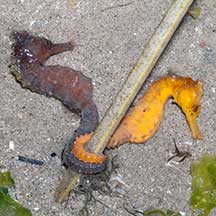 Often seen in a pair. Flexible tail used to hang onto objects. Tanah Merah, Aug 09 |
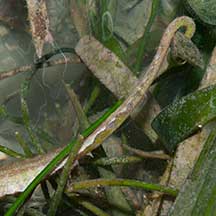 The Alligator pipefish also has a rehensile tail. Cyrene Reef, May 08 |
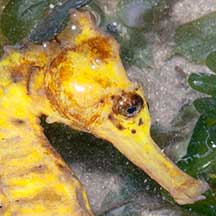 Mobile eyes can move while the body remains still. Toothless jaws used like a straw. Changi, Jul 07 |
| Pregnant fathers: In many members of this family, the male carries the eggs. In some species, the male has a pouch. For those without a pouch, such as pipefishes, the eggs may be glued to the underside of the male's tail or abdomen. Often the eggs are embedded in a spongy tissue. Some have a pair of flaps that fold over the eggs. Females have an ovipositor to lay eggs on the male's body, where the eggs are then fertilised. In some species, 'pregnant' males may hang out together in small groups. The eggs develop safely on dad's body. The father 'gives birth' to live young, which emerge as miniatures of the adults. |
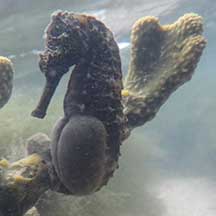 Very pregnant seahorse papa. Sisters Island, Mar 12 |
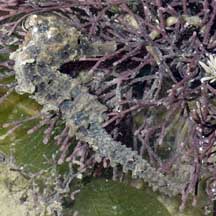 Some seahorses are tiny! Watch your step! Changi, Jul 06 |
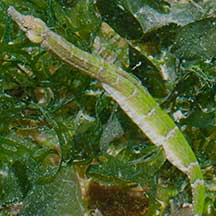 Very pregnant piepfish papa. Changi, Jun 13 |
| Human uses: Pipefishes and seahorses
are used in traditional Chinese medicine. Some species are also caught
for the live aquarium trade. Status and threats: These fishes are threatened by habitat disturbance and destruction from reclamation, pollution and activities that increase sedimentation. They are also threatened with over-collection for the traditional Chinese medicine and live aquarium trade. They are naturally uncommon because they reproduce slowly and usually seldom travel far from one spot. Usually, in the wild only a handful of babies survive from each batch of eggs. Being slow swimmers without a free-swimming larval stage, they don't spread quickly to new places. Being slow-moving and defenceless, they are easily collected. Like other fish and creatures harvested for the live aquarium trade, most die before they can reach the retailers. Without professional care, most die soon after they are sold. Those that do survive are unlikely to breed successfully. Llike other creatures of the intertidal zone, they are affected by human activities such as reclamation and pollution. Poaching by hobbyists can also have an impact on local populations. |
Family
Syngnathidae recorded for Singapore
|
Links
References
|